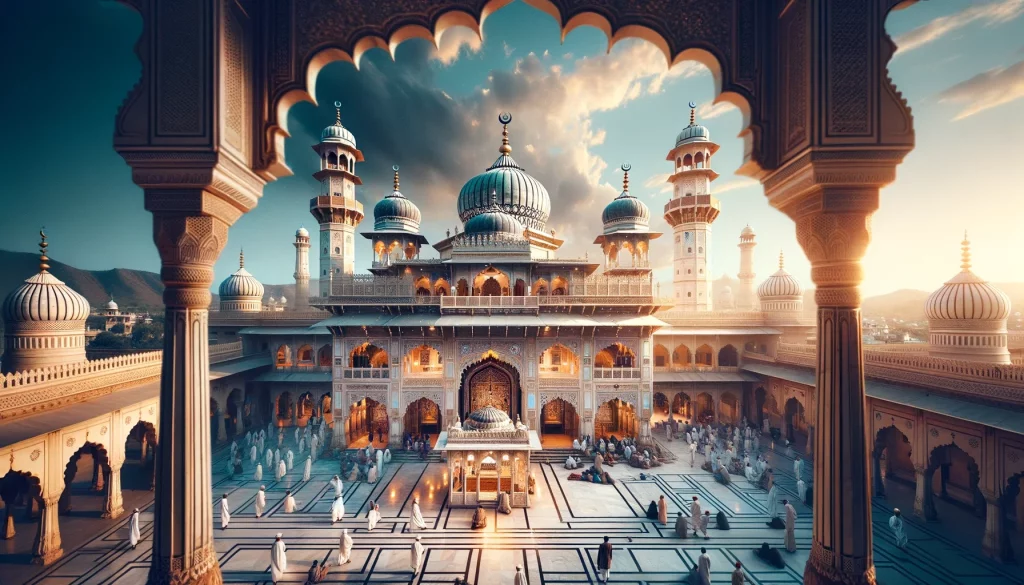Best Time to Visit Ajmer Sharif Dargah – A Complete Guide

Introduction
Welcome, dear readers! Today, we’re embarking on a journey to unravel the best time to visit one of India’s most revered and mystically charged places – the Ajmer Sharif Dargah. Nestled in the heart of Rajasthan, this shrine isn’t just a pilgrimage site; it’s a mosaic of culture, faith, and history. And guess what? Deciding when to visit can be as tricky as choosing the perfect spices for your biryani!
Why Ajmer Sharif Dargah?
- Personal Connection: Having visited this sacred place twice, I can vouch for its mesmerizing aura. The first visit was unplanned, during the scorching heat of June, and let’s just say, it was more sweat than serenity!
- Spiritual Magnetism: There’s something about the Dargah that draws not just the faithful but also curious travelers. The blend of devotion and history here is simply unparalleled.
The Mystique of Ajmer Sharif Dargah
Now, let’s talk about why Ajmer Sharif Dargah is more than just a religious site. It’s a symbol of unity and spiritual solace.
- Historical Significance: The Dargah is the tomb of Sufi Saint, Khwaja Moinuddin Chishti, a spiritual figure who played a pivotal role in spreading the values of love and humanity in India.
- Cultural Melting Pot: From Qawwali sessions that touch your soul to the vibrant Urs festival, this place is a testament to India’s composite culture. It’s where music transcends religion and where faith goes beyond boundaries.
Geographical and Climatic Considerations
Understanding Ajmer’s geography and climate is crucial in planning your visit. Let’s break it down:
- Location: Situated in the northern part of India, Ajmer experiences a typical subtropical climate. But don’t let the ‘subtropical’ tag fool you – the weather here has its own mood swings!
- Seasonal Variations:
- Summer (April to June): It’s like walking into a sauna. I remember my June visit; my sunglasses literally fogged up the moment I stepped outside!
- Monsoon (July to September): Picture this: the Dargah amidst rain showers, the aroma of wet earth, and fewer crowds. It’s tranquil but hey, rain can be a party pooper too.
- Winter (October to March): Now, this is what I call the sweet spot. Pleasant days and nippy evenings. It’s when Ajmer dons its most welcoming guise.
Best Times to Visit: An In-Depth Look
Choosing the right time to visit Ajmer Sharif Dargah can make all the difference in your experience. Here’s my month-by-month breakdown:
- January to March: The Serene Start
- Cool and Pleasant: Ideal for those who prefer a calm and spiritual ambiance without the rush.
- My Take: I visited in February once, and the cool breeze during the evening Qawwali was nothing short of magical.
- April to June: The Scorching Challenge
- Intensely Hot: Not for the faint-hearted! But hey, if you can brave the heat, the crowd is thinner.
- A Different Perspective: I found the summer’s harshness brought a unique, quiet introspection to my visit.
- July to September: The Monsoon Magic
- Rainy and Romantic: The monsoon showers bring a refreshing change, though they can be unpredictable.
- Insider Tip: If you don’t mind getting a bit wet, the rain-laden ambiance of the Dargah is a photographer’s paradise.
- October to December: The Cultural Fiesta
- Pleasant Weather: The best of Ajmer, with mild temperatures and clear skies.
- Festival Highlight: If you’re around in November, the Urs festival is a spectacle not to be missed – it’s vibrant, spiritual, and truly embodies the spirit of the Dargah.
Cultural Events and Festivals
Ajmer Sharif Dargah is not just about the place, it’s about the experience. And what better way to experience it than during its festivals?
- Urs Festival:
- What’s It About: Celebrating the anniversary of Saint Moinuddin Chishti, it’s a blend of devotion, music, and culture.
- Personal Reflection: The energy during Urs is electrifying. The blend of colors, the soulful music, and the collective spirit of peace is something that stays with you.
- Ramadan and Eid:
- A Time of Reflection: The holy month of Ramadan and the celebration of Eid bring a unique solemnity and joy to the Dargah.
- Why Visit Now: Experience the communal iftars (breaking of the fast) – a true testament to the Dargah’s spirit of brotherhood and charity.
Practical Tips for Visitors
Visiting a place like Ajmer Sharif Dargah comes with its own set of nuances. Here are some tips to enhance your experience:
- Accommodation: Choose a place close to the Dargah for easy access. There are options for every budget.
- Local Transportation: Auto-rickshaws are your best bet. Negotiate the fare in advance to avoid surprises.
- Cultural Norms: Respect is key. Dress modestly and be mindful of the sanctity of the place.
- Food: Don’t miss out on the local cuisine. The nearby eateries offer some lip-smacking dishes that are a must-try.
- Engage with the Locals: Ajmer’s residents are known for their hospitality. A chat with a local can give you insights no guidebook can.
Photography and Etiquette at the Dargah
Capturing the essence of Ajmer Sharif Dargah through a lens is a photographer’s dream, but there are a few things to keep in mind:
- Photography:
- Inside the Dargah: Photography is generally allowed, but always ask for permission first. It’s a sign of respect.
- Capturing Emotions: The real beauty lies in the candid moments of devotion and interaction among pilgrims. These make for the most heartfelt photographs.
- My Experience: I once captured an elderly man lost in prayer – the picture spoke a thousand words about faith and tranquility.
- Etiquette:
- Dress Respectfully: Conservative attire is recommended. Cover your head as a sign of respect.
- Behavior: Maintain a quiet demeanor. This is a place of worship, after all.
- Donations: While not mandatory, small donations to the Dargah are a way of contributing to its upkeep.
Nearby Attractions
While the Dargah is the centerpiece of Ajmer, the city and its surroundings have much more to offer:
- Ana Sagar Lake:
- A Tranquil Escape: Just a short drive from the Dargah, this lake is perfect for a peaceful evening.
- Boating and Views: The sunset views from here are absolutely stunning.
- Ajmer Fort:
- A Glimpse into History: For history buffs, the fort is a must-visit. Its architecture and the stories behind it are fascinating.
- Pushkar:
- A Short Trip Away: About 30 minutes from Ajmer, Pushkar is known for its Brahma Temple and serene Pushkar Lake.
- Cultural Fest: If you’re there during the Camel Fair, it’s an experience you won’t forget.
Conclusion
So, there you have it – a comprehensive guide to making the most of your visit to Ajmer Sharif Dargah and its surroundings. Whether you’re drawn by faith, culture, or simply the allure of the unknown, Ajmer promises an experience that’s as enriching as it is enlightening.
I’d love to hear your thoughts and experiences about Ajmer Sharif Dargah or any questions you might have. Planning a visit? Drop a comment, and let’s help each other out. And if you’ve already been there, share your stories! Let’s keep the conversation going and build a community of travel enthusiasts who appreciate the deeper aspects of visiting such unique places.



0 Comments